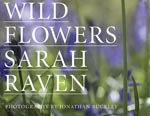Book Review: Gardening: Wild Flowers
Knowledge built over years of fieldwork makes this book useful, as well as striking a chord with the enthusiast


To order any of the books reviewed or any other book in print, at
discount prices* and with free p&p to UK addresses, telephone the Country Life Bookshop on Bookshop 0843 060 0023. Or send a cheque/postal order to the Country Life Bookshop, PO Box 60, Helston TR13 0TP * See individual reviews for CL Bookshop price.
Gardening Wild Flowers Sarah Raven (Bloomsbury, £50, *£40)
Good books on the British flora generally fall into one of two categories: readily portable field guides, and larger books of drawings ideal for double-checking in the evening. This book is neither. It is big, heavy and 2in thick, and will fit into no glovebox known to me. Do not think, however, that this rules out its utility.
The whole volume radiates knowledge built up over years of determined fieldwork, knowledge of a kind that will surely satisfy instinctive cynics. Covering everything from the mountain pansies of Upper Teesdale to the navelwort of Cornish hedges, the book carries the authentic stamp of personal experience tempered by expert understanding and, most elusively, the unmistak-able thrill of discovery.
Sarah Raven chooses to organise the content not by botanical family, but by habitat, so that we begin with woodland flowers and progress through hedgerows, meadows and so forth to the coast. This is an excellent method, and makes the volume of real use.
However, there is more than mere usefulness here. The descriptions combine the truth of observation it is, indeed, the case that the glorious scent of the sweet violet can only be appreciated by lying down and placing your nose immediately above it-with the kind of energetic, spontaneous prose that strikes a chord with the fellow enthusiast. A flush of wood anemone, for instance, reminds the author of ‘a group of five-year-old girls in their tutus, going off to their first ballet lesson', and ‘If wild flowers had a beauty parade, honeysuckle would win Miss British Isles'.
Sign up for the Country Life Newsletter
Exquisite houses, the beauty of Nature, and how to get the most from your life, straight to your inbox.
Refreshingly, the author is also unafraid to include such controversial incomers as giant hogweed and Spanish bluebell, according them their worth as established features of the countryside, without failing to note their unwelcome qualities. And who else would recommend dock for flower arranging? Jonathan Buckley's excellent photographs strike a desirable balance between close-up detail and the wider context. There are several complementary indices at the back. All in all, this is a successful attempt to produce a book on a tricky subject that answers the age-old demand for things that are both useful and beautiful.
Country Life is unlike any other magazine: the only glossy weekly on the newsstand and the only magazine that has been guest-edited by HRH The King not once, but twice. It is a celebration of modern rural life and all its diverse joys and pleasures — that was first published in Queen Victoria's Diamond Jubilee year. Our eclectic mixture of witty and informative content — from the most up-to-date property news and commentary and a coveted glimpse inside some of the UK's best houses and gardens, to gardening, the arts and interior design, written by experts in their field — still cannot be found in print or online, anywhere else.
-
 What's a 'wellness village' and will it tempt you back into the office?
What's a 'wellness village' and will it tempt you back into the office?The team behind London's first mixed-use ‘wellness village’ says it has the magic formula for tempting workers back into offices.
By Annunciata Elwes
-
 'To exist in this world relies on the hands of others': Roger Powell and modern British bookbinding
'To exist in this world relies on the hands of others': Roger Powell and modern British bookbindingAn exhibition on the legendary bookbinder Roger Powell reveals not only his great skill, but serves to reconnect us with the joy, power and importance of real craftsmanship.
By Hussein Kesvani